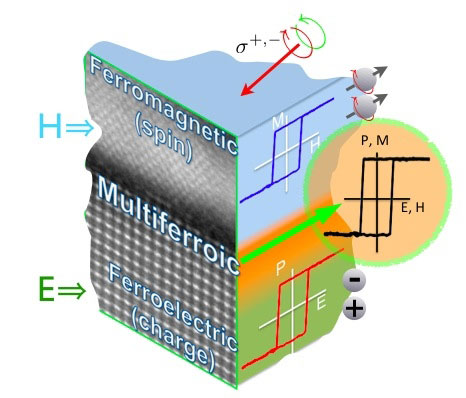 An international team of researchers from France and Germany has developed a new material which is the first to react magnetically to electrical fields at room temperature. Previously this was only at all possible at extremely low and unpractical temperatures.
An international team of researchers from France and Germany has developed a new material which is the first to react magnetically to electrical fields at room temperature. Previously this was only at all possible at extremely low and unpractical temperatures.
Aug 23rd, 2011
Read more
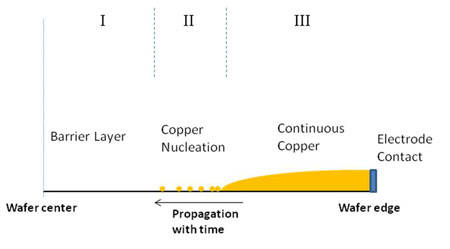 The focus of a new collaboration is to develop a simulation platform that can be used as a tool for exploring new electrodeposition strategies. By combining the expertise fields of experiments and simulations and their mutual validation, the project aims at yielding a simulation tool which captures the essential processes occurring at wafer level, and thus handle 'real case' situations. The project's results will be fed into the development work for both the 3D and advanced interconnect programs.
The focus of a new collaboration is to develop a simulation platform that can be used as a tool for exploring new electrodeposition strategies. By combining the expertise fields of experiments and simulations and their mutual validation, the project aims at yielding a simulation tool which captures the essential processes occurring at wafer level, and thus handle 'real case' situations. The project's results will be fed into the development work for both the 3D and advanced interconnect programs.
Aug 22nd, 2011
Read more
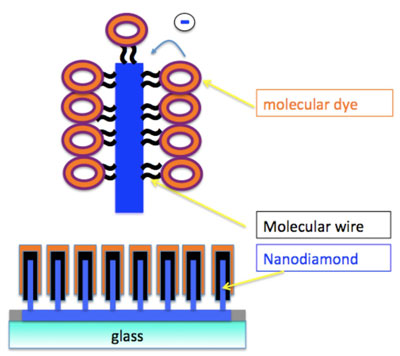 A new European project called MOLESOL has been set up to demonstrate a revolutionary pathway for fabricating low-cost, high-efficiency and stable solar cells. The envisaged solar cell will be a hybrid device that consists of dye monolayers that are linked through an organic molecular wire to a semiconducting thin film deposited on a transparent substrate.
A new European project called MOLESOL has been set up to demonstrate a revolutionary pathway for fabricating low-cost, high-efficiency and stable solar cells. The envisaged solar cell will be a hybrid device that consists of dye monolayers that are linked through an organic molecular wire to a semiconducting thin film deposited on a transparent substrate.
Aug 22nd, 2011
Read more
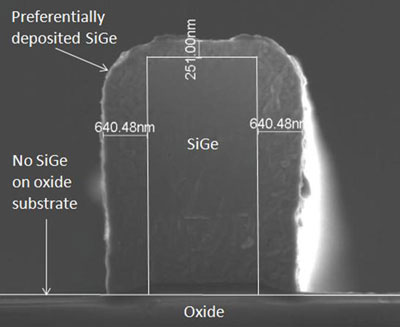 Imec has developed a new method for the preferential deposition of silicon-germanium through chemical vapor deposition. They have further engineered this method into an innovative technique for trench narrowing and via filling through deposition only, i.e. without the need of litho/etch and subsequent chemical mechanical polishing. This technique offers a path to decreasing the number of process operations and thus reducing IC manufacturing costs.
Imec has developed a new method for the preferential deposition of silicon-germanium through chemical vapor deposition. They have further engineered this method into an innovative technique for trench narrowing and via filling through deposition only, i.e. without the need of litho/etch and subsequent chemical mechanical polishing. This technique offers a path to decreasing the number of process operations and thus reducing IC manufacturing costs.
Aug 22nd, 2011
Read more
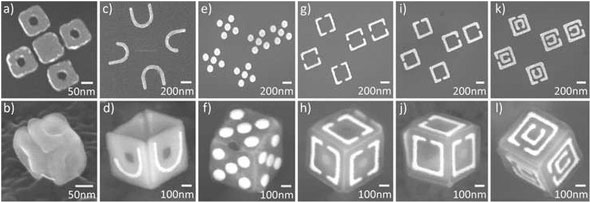 This summer, imec welcomed 4 students from John Hopkins University (JHU), a world-class university in Baltimore, US, for a research internship of 10 weeks in the field of bioelectronics. These internships coincide with the announcement of a scientific story on nanoscale origami that has resulted from the internship of the first JHU visiting student in the summer of 2009 with a follow-on program last year. In this work, an approach is presented that allows generating precisely patterned polyhedral nanostructures, envisaged for optical and biosensing applications.
This summer, imec welcomed 4 students from John Hopkins University (JHU), a world-class university in Baltimore, US, for a research internship of 10 weeks in the field of bioelectronics. These internships coincide with the announcement of a scientific story on nanoscale origami that has resulted from the internship of the first JHU visiting student in the summer of 2009 with a follow-on program last year. In this work, an approach is presented that allows generating precisely patterned polyhedral nanostructures, envisaged for optical and biosensing applications.
Aug 22nd, 2011
Read more
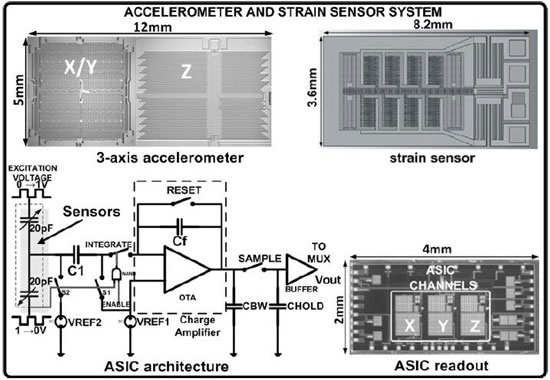 Imec and Holst Centre report an ultralow-power readout ASIC for capacitive MEMS/NEMS-based sensors. The system can read both accelerometers and strain sensors in a half-bridge configuration.
Imec and Holst Centre report an ultralow-power readout ASIC for capacitive MEMS/NEMS-based sensors. The system can read both accelerometers and strain sensors in a half-bridge configuration.
Aug 22nd, 2011
Read more
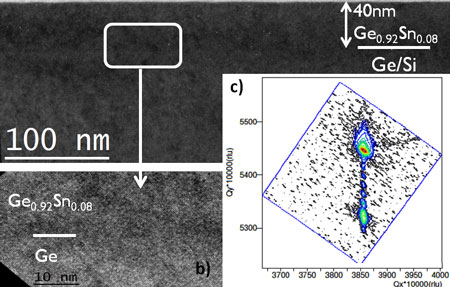 Imec reports for the first time selective chemical vapor deposition (CVD) of GeSn in a production-like environment using commercially available Ge and Sn precursors. The resulting GeSn layers with 8% Sn are defect free, fully strained and thermally stable for temperatures up to 500 C. This technique is used to implement uniaxial compressive stress in a Ge channel, the key method for reaching very high mobility values in MOSFETs.
Imec reports for the first time selective chemical vapor deposition (CVD) of GeSn in a production-like environment using commercially available Ge and Sn precursors. The resulting GeSn layers with 8% Sn are defect free, fully strained and thermally stable for temperatures up to 500 C. This technique is used to implement uniaxial compressive stress in a Ge channel, the key method for reaching very high mobility values in MOSFETs.
Aug 22nd, 2011
Read more
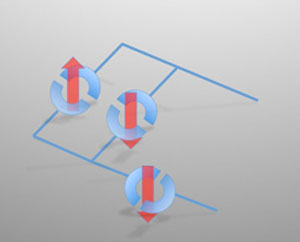 Researchers from the London Centre for Nanotechnology and the Physics Department of Sapienza University of Rome have discovered a technique to 'draw' superconducting shapes using an X-ray beam. This ability to create and control tiny superconducting structures has implications for a completely new generation of electronic devices.
Researchers from the London Centre for Nanotechnology and the Physics Department of Sapienza University of Rome have discovered a technique to 'draw' superconducting shapes using an X-ray beam. This ability to create and control tiny superconducting structures has implications for a completely new generation of electronic devices.
Aug 22nd, 2011
Read more
Yoshiyuki Miyamoto from the Dynamic Process Simulation Group at the the Nanosystem Research Institute of the National Institute of Advanced Industrial Science and Technology (AIST), has performed the first-principles simulations that consistently treat from optical excitation to electron-hole splitting in a photovoltaic material formed by molecules having different electron affinities.
Aug 22nd, 2011
Read more
The LOASIS program at the U.S. Department of Energy's Lawrence Berkeley National Laboratory (Berkeley Lab) has already demonstrated high-quality beams up to a billion electron volts in a mere 3.3 centimeters; the BELLA project will reach 10 billion electron volts in a single meter.
Aug 22nd, 2011
Read more
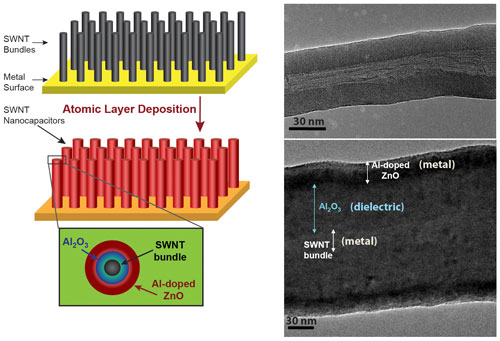 Rice University researchers have created a solid-state, nanotube-based supercapacitor that promises to combine the best qualities of high-energy batteries and fast-charging capacitors in a device suitable for extreme environments.
Rice University researchers have created a solid-state, nanotube-based supercapacitor that promises to combine the best qualities of high-energy batteries and fast-charging capacitors in a device suitable for extreme environments.
Aug 22nd, 2011
Read more
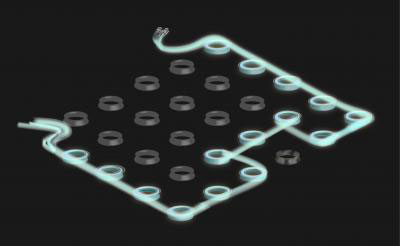 Surprisingly, transmitting information-rich photons thousands of miles through fiber-optic cable is far easier than reliably sending them just a few nanometers through a computer circuit. However, it may soon be possible to steer these particles of light accurately through microchips thanks to new research.
Surprisingly, transmitting information-rich photons thousands of miles through fiber-optic cable is far easier than reliably sending them just a few nanometers through a computer circuit. However, it may soon be possible to steer these particles of light accurately through microchips thanks to new research.
Aug 22nd, 2011
Read more
Discovery may be key to solar energy and smart glass technologies.
Aug 22nd, 2011
Read more
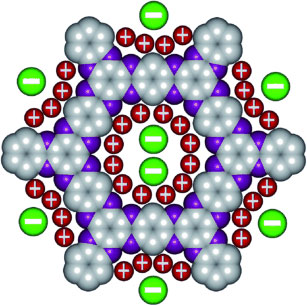 A team led by Dinglin Jiang at the National Institutes of Natural Sciences in Okazaki has introduced a new material with outstanding supercapacitor properties.
A team led by Dinglin Jiang at the National Institutes of Natural Sciences in Okazaki has introduced a new material with outstanding supercapacitor properties.
Aug 22nd, 2011
Read more
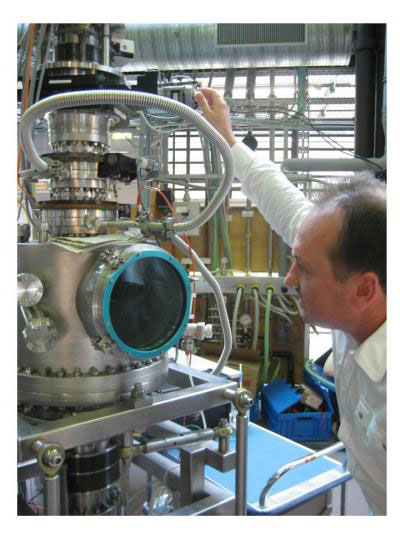 HZB scientists observe how a material at room temperature exhibits a unique property - a 'multiferroic' material with potential uses for cheap and quick data storage.
HZB scientists observe how a material at room temperature exhibits a unique property - a 'multiferroic' material with potential uses for cheap and quick data storage.
Aug 22nd, 2011
Read more
Download a new white paper on the potential of incorporating benign chemistry practices.
Aug 22nd, 2011
Read more
 An international team of researchers from France and Germany has developed a new material which is the first to react magnetically to electrical fields at room temperature. Previously this was only at all possible at extremely low and unpractical temperatures.
An international team of researchers from France and Germany has developed a new material which is the first to react magnetically to electrical fields at room temperature. Previously this was only at all possible at extremely low and unpractical temperatures.











 Subscribe to our Nanotechnology News feed
Subscribe to our Nanotechnology News feed